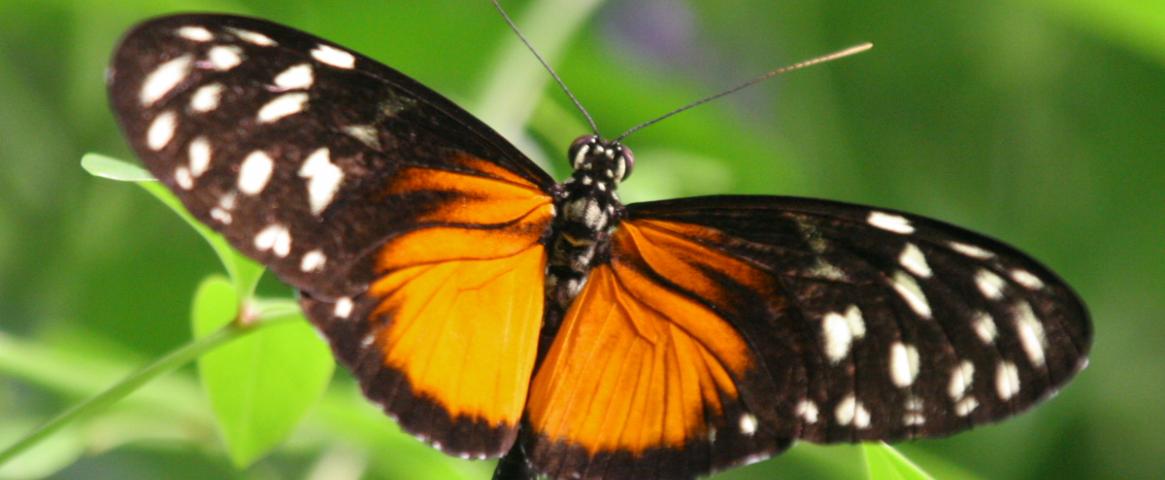By Shi En Kim
Time and pollen wait for no Heliconius. Luckily, Heliconius butterflies have a good sense of time: in the wild, they forage from flowers, and scientists have seen them alter foraging habits depending on the time of day to match flowers’ pollen-release schedules. Wyatt Toure, a graduate student in biology at McGill University, wondered whether they were smart enough to apply that sense of time to new, human-designed tasks.
To test the butterflies’ ability to learn different behaviors for different times, Toure and his colleagues set up a butterfly bootcamp for Heliconius at the Smithsonian Tropical Research Institute in Gamboa, Panama. This study, which is posted to the database bioRxiv and has yet to be published in a journal, marks the first lab demonstration of learned time-dependent behavior in any butterflies.
This skill puts them in good company: for instance, ants and bees remember when and where to show up for a feeding routine. These insects are typically social and associated with higher intelligence. But fewer researchers have studied the cognitive abilities of more solitary insects such as beetles and butterflies, painting an incomplete picture of insect intelligence.
“[Demonstrating learning in butterflies] is not straightforward to carry out,” says Melissa Whitaker, a research associate in biocommunication and ecology at ETH Zurich who wasn’t involved in the study. “It takes a good model species. Heliconius seems like an appropriate choice based on field observations.”
For 10 days, Toure and colleagues trained Heliconius butterflies to develop time-based color preferences. In the morning, the researchers fed the butterflies from yellow or purple feeders filled with sugary water or bitter quinine. They then switched the feeders’ contents later in the day, so the butterflies would learn to prefer different color feeders in the mornings and the afternoons.
Three quarters of the 41 total butterflies proved tractable; the remainder were too eccentric to respond to any of Toure’s time or color cues. As a final test, the researchers exposed the trained butterflies to empty colored feeders, then recorded their feeding attempts throughout the day.
“A few [butterflies] did really well during training, and that was reflected in their final test preferences,” Toure says. “When a butterfly is performing well during training, it feels good. It’s like, ‘Yes Number two, you did really good today.'”
“There were some superstar butterflies,” he added.
Examining the 16 top performers in the training session, the researchers recorded a switch in color preferences by 11% between the morning and the afternoon corresponding to their training, similar to the shift in flower visits seen in wild Heliconius butterflies. Toure’s butterflies had passed — with flying colors.
Randolf Menzel, a bee neurology expert at Free University Berlin who wasn’t involved in the study, says he thinks the butterflies’ scores could be even higher with a more tailored test. Butterflies are more difficult to train than bees, he says. In anthropomorphic terms, they can be stubborn and whimsical students. “[Adapting the training] more to the biology of this particular species of butterfly […] would most likely get better learning scores.”
In a secondary experiment, Toure and colleagues wondered whether time-associated learning was only prevalent in pollen-feeding butterflies such as Heliconius as they uniquely depend on pollen for reproduction. The researchers performed the same time-association training in Heliconius’s cousin Dryas iulia, which doesn’t feed on pollen nor demonstrate the same foraging patterns. To their surprise, half of the Dryas butterflies were trainable, and those individuals scored even better than Heliconius did on the color preference task — suggesting it’s not just Heliconius’s ecological niche that dictates this skill.
“It brings up a bunch of other questions,” says Toure.
At first glance, butterflies’ time-associated smarts aren’t as impressive as the brainpower of honey bees, the reigning intelligentsia of the insect world. Honey bees can communicate the locations of food sources through a waggle dance, play soccer to earn rewards, solve complex pathfinding challenges such as the Travelling Salesperson problem, and even understand the concept of zero.
Bee intelligence has been studied for over a century, whereas historically, butterflies have been an emblem of aesthetics. Researchers have only relatively recently begun to ponder their cognitive abilities, too. Toure’s work has made an important first step by demonstrating one way butterflies can be trained, suggesting that more advanced cognitive tasks are possible in a laboratory setting.
“I think butterflies are on the up and coming on studies of insect learning and memory,” says Toure. “Bee researchers better watch out.”
Shi En Kim (@goes_by_kim) is a freelance science writer and graduate student in molecular engineering at the University of Chicago.
This story was produced as part of NASW's David Perlman Summer Mentoring Program, which was launched in 2020 by our Education Committee. Kim was mentored by Sarah Lewin Frasier.





